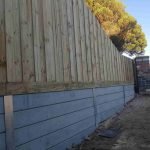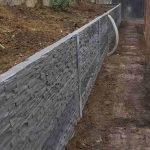
Changing Outdoor Areas with Proficient Retaining Wall Installers
Introduction
Transforming outdoor areas is not almost aesthetic appeals; it's about functionality and sustainability. One of the most reliable ways to attain this is through the installation of maintaining walls. Retaining walls serve a vital function in managing soil erosion, developing flat surfaces for landscaping, and improving the total appeal of your garden or lawn. However attaining a perfect retaining wall requires competence, skill, and the best materials. This short article will look into the world of skilled retaining wall installers and how they can transform your outdoor area utilizing various materials like timber sleeper, concrete sleeper, and H beam
Understanding Retaining Walls: The Basics
What is a Retaining Wall?
A retaining wall is a structure developed to keep back soil and avoid erosion. They are typically utilized in landscaping to produce terraces or leveled locations in sloped yards.
Why Are Maintaining Walls Important?
Retaining walls are vital for numerous reasons:
- Erosion Control: They help avoid soil from sliding down slopes.
- Landscaping Opportunities: Produce functional flat areas on sloped land.
- Aesthetic Appeal: They can enhance the look of your garden.
Materials Used in Retaining Wall Construction
Timber Sleeper
Timber sleepers are a popular option for maintaining walls due to their natural look and ease of usage.
Advantages of Lumber Sleepers
Disadvantages of Wood Sleepers
Concrete Sleeper
Concrete sleepers have actually ended up being increasingly popular due to their strength and durability.
Advantages of Concrete Sleepers
Disadvantages of Concrete Sleepers
H Beam
H beams use structural support for bigger keeping walls that need extra stability.
Advantages of H Beams
retaining walls installersDisadvantages of H Beams
Choosing the Right Installer
What Makes a Professional Installer?
When it pertains to changing outside areas with knowledgeable retaining wall installers, professionalism matters immensely. A professional installer must possess:
- Extensive experience in numerous materials consisting of timber sleeper, concrete sleeper, and H beam.
- A robust portfolio showcasing previous projects.
- Positive customer testimonials reflecting reliability and quality work.
Questions to Ask Prospective Installers
- What materials do you recommend for my specific project?
- Can you provide recommendations from previous clients?
- Do you have liability insurance?
The Installation Process: Action by Step
Initial Consultation
Before any work starts, an initial consultation with the installer is crucial to comprehend your needs, spending plan, and vision.
Site Assessment
The installer will evaluate your residential or commercial property's topography, drain systems, and prospective challenges during installation.
Designing the Wall
Collaborating with an expert permits you to pick the best design fit for your landscape while making sure structural integrity.
Preparing the Site
This involves clearing the area where the wall will be put, which may include eliminating greenery or debris.
Building the Wall
Finally, skilled installers will implement their expertise in setting either wood sleepers, concrete sleepers, or H beams according to plan specifications while making sure safety requirements are met.
Maintenance Tips for Your Retaining Wall
Regular Inspections
Check for indications of wear or damage a minimum of twice a year, specifically after heavy rain or storms.
Drainage Solutions
Proper drain is essential! Make sure that water streams far from your retaining wall to avoid saturation which can lead to failure over time.
Cleaning
Keep it clean! Get rid of any particles that collects on the top or around your wall which can trap moisture against its surface.
FAQs About Retaining Walls
Q1: The length of time does it require to install a keeping wall?
A: The installation timeframe varies based on size and product however typically ranges from 1-5 days depending on complexity.
Q2: Can I develop my own retaining wall?
A: While it's possible for do it yourself enthusiasts who have experience, employing experts ensures much better results concerning security and longevity.
Q3: Just how much does it cost to set up a retaining wall?
A: Expenses vary commonly based upon product options (timber sleeper vs concrete sleeper), size, area specifics; expect anywhere from $15-$50 per square foot set up professionally.

Q4: Do I need permits for building a retaining wall?
A: Yes! Many regional authorities require authorizations specifically if the wall goes beyond specific height limits-- consult with experts who understand local regulations!
Q5: Will my plants be affected by a new keeping wall?
A: It depends on positioning; nevertheless correct preparation by professionals can decrease disturbance while improving total landscape health!
Q6: How do I choose between timber sleeper and concrete sleeper?
A: Think about visual appeals versus sturdiness; if you're looking for something gorgeous that blends naturally choose lumber however if durability is essential then lean towards concrete!
Conclusion
Transforming outside areas with competent retaining wall installers is not simply about erecting structures; it's about crafting tailored options that balance performance with visual appeal. Whether you opt for timber sleeper walls that evoke rustic beauty or durable concrete sleepers created for durability-- understanding your alternatives empowers you as a house owner! Seeking professional aid guarantees every element of setup satisfies high standards while attending to both immediate requirements and future upkeep concerns efficiently! So why wait? Accept this opportunity today; turn your landscape dreams into reality by working together with knowledgeable installers who bring development right into your backyard!